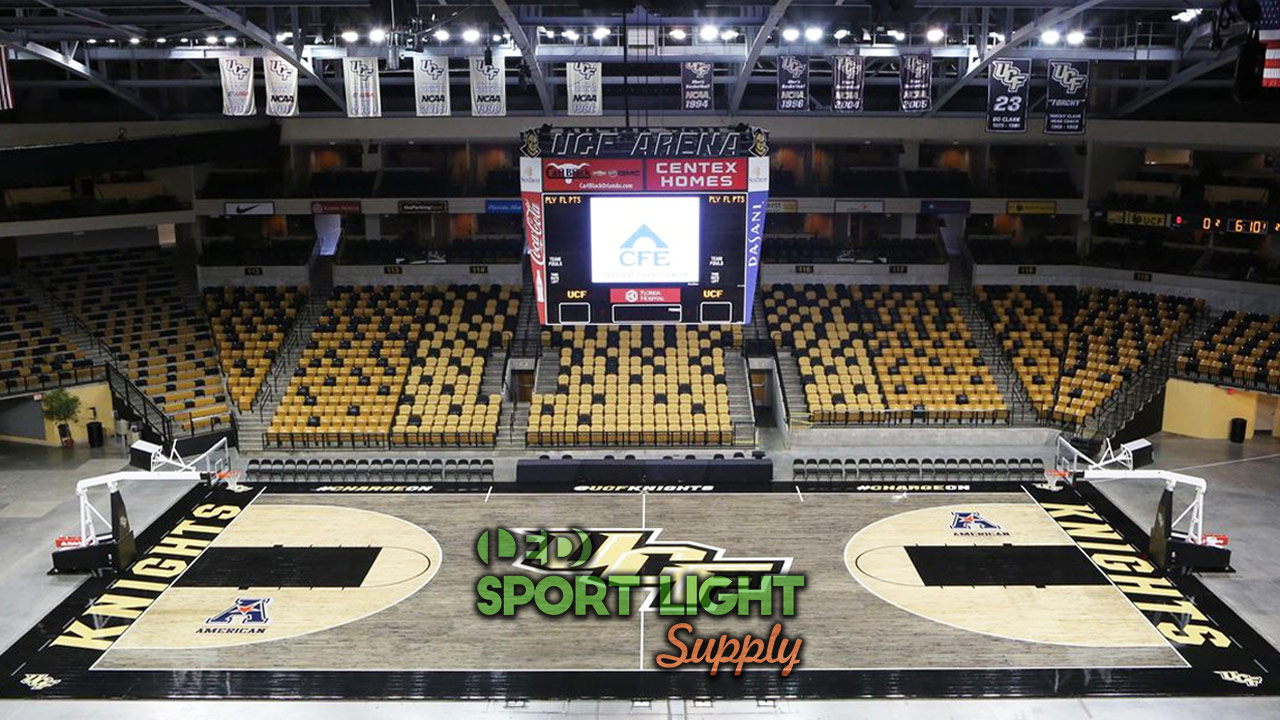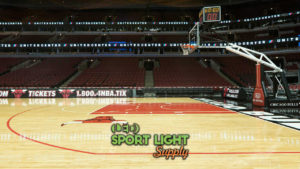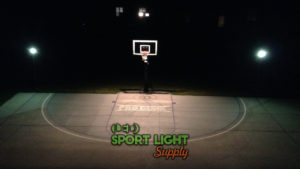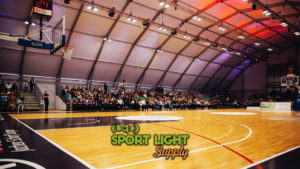Determining the correct amount of lumens is the first step to comply with a basketball court lighting standard. For clarity, the total lumen output depends on the targeted lux level. In the US, the foot candle unit system replaces the lux unit. Check with your association to find out the most suitable lux level requirement for your stadium or outdoor arena.
About the total amount of lumens you need for basketball court lighting
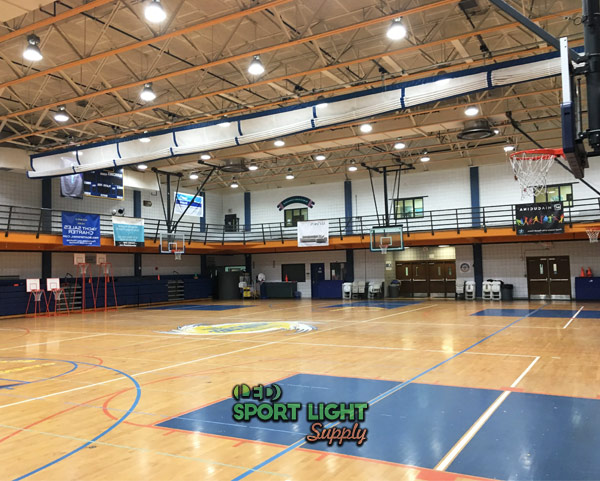 Before reading the formula in the last section, you will find three classes of lighting systems. You can use the formula to calculate the total amount of lumens. But make sure that the lux level is in line with the provided classes. If your association did not give you a precise lux level, refer to our three classes as minimal values.
Before reading the formula in the last section, you will find three classes of lighting systems. You can use the formula to calculate the total amount of lumens. But make sure that the lux level is in line with the provided classes. If your association did not give you a precise lux level, refer to our three classes as minimal values.
Basketball players can score points in different areas of the playing field. As a result, a basket can be worth one, two, or three points. So, the lighting system must provide comfortable vision. As the lights must never blind players trying to score within the arc, excessive brightness is also unsafe.
How many lux & footcandles does an indoor & outdoor basketball court need?
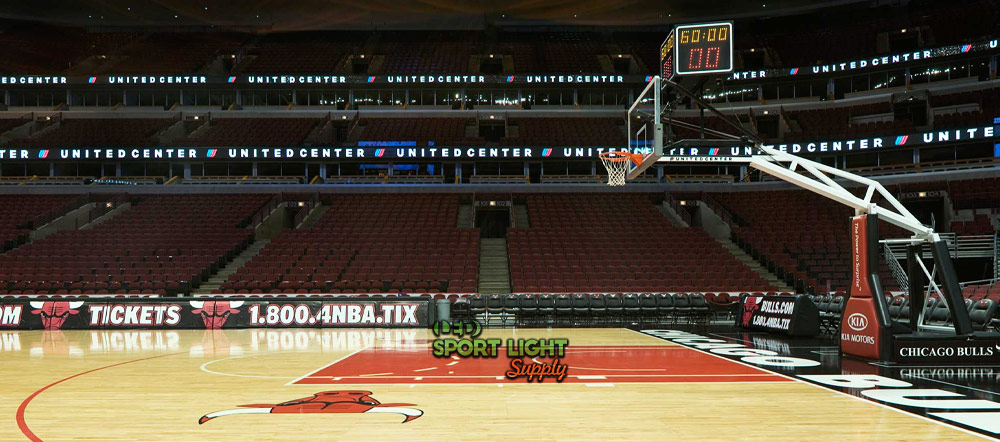
The lighting design of a basketball court must provide enough light for games and special events. As you know, the stadium owner may host televised and non-televised games. So, the light levels reflect ideal values for the best illuminance conditions.
In brief, three classes of lighting apply. These classes are:
- International and first-rate matches (class I)
- National basketball leagues (class II)
- Regional and local lighting standard for high school matches and training (class III)
Indoor events require higher lux levels than outdoor ones. In detail, class I events need 750 lux (69,67 fc). Class II games need 500 lux (46,45 fc). Finally, only 200 lux (18,58 fc) are necessary for class III activities. For outdoor events, respectively, you need:
- less than 500 lux (46,45 fc) for class I
- around 200 lux (18,58 fc) for class II
- no more than 75 lux (7 fc) for class III
Lighting uniformity and CRI values
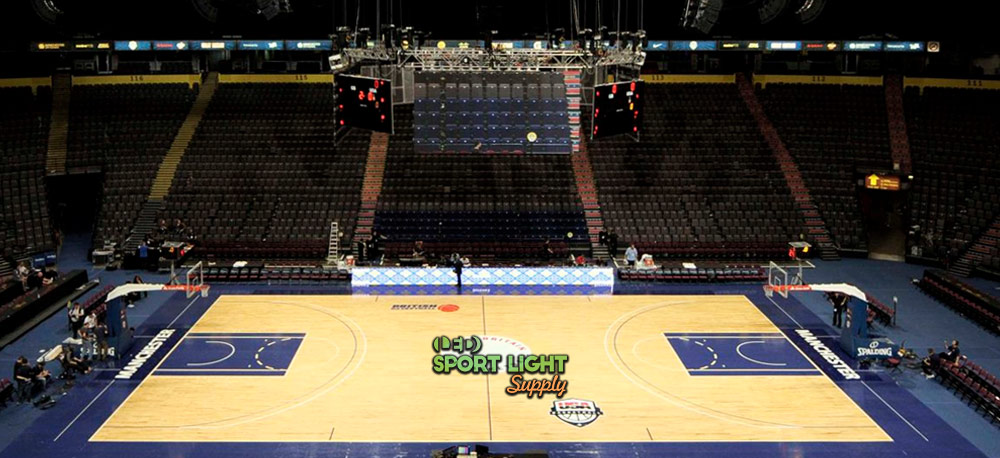
The lighting standard also includes Uniformity values. For the best results, a Uniformity rating of 0.7 is recommendable at any level. However, a Uniformity of 0.5 for class III activities is also fine. For class I televised games, a CRI (color rendering index) of 60 Ra represents the minimum value. You should use light sources with a minimum of 60 Ra in any case for comfortable vision. Although training and class III events only require 20 Ra.
How many lumens does an outdoor basketball court need?
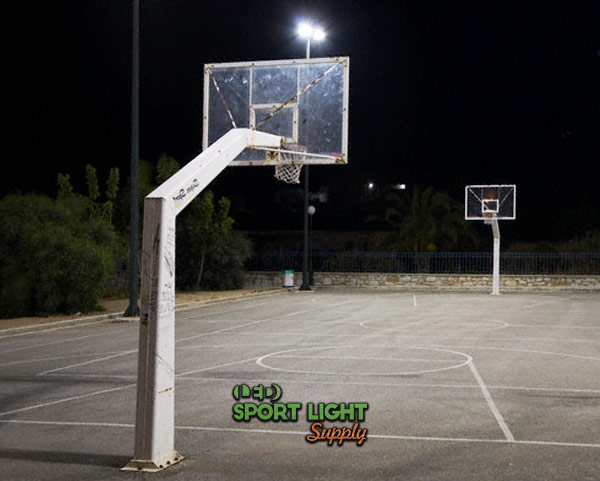 The basic formula to calculate the total amount of lumen is:
The basic formula to calculate the total amount of lumen is:
lux x area (sq. meter) x 1.2 (light loss factor) = lumens.
For clarity, the light loss factor depends on several elements like lamp tilt, surface depreciation, dirt, the temperature of the luminaries. Instead, the lux value refers to the desired lux level. For example, here is the total amount of lumens for a class II game played on 436 sq. meter basketball court:
500 lux x 436 sq. meter x 1.2 = 261,600 lumens
After you calculate the total lumens, you will have to deal with other limiting factors. For example, the building code. In an outdoor venue, you might not install high masts higher than a given limit. Or you might have to abide by city lighting ordinances. Especially to prevent light pollution at night.
When hosting a televised match, be aware that only flicker-free lights must generate the necessary lumen amount. Otherwise, broadcasters will complain about flickering. The recording or streaming quality will suffer. Such a lack of flicker-free lights can cause you to lose future sports broadcasting contracts.
The fastest way to achieve a perfect lighting design
If you have a standard NBA basketball stadium, you might want to go for a professional DIALux lighting design. The reason why that is has to do with the current lighting standard for televised basketball games. First of all, here is the total amount of lumens that you need to light up an NBA basketball arena:
750 lux x 495 sq. meter x 1.2 = 445,500 lumens
Besides the total lumens, the illuminance requirement includes lighting uniformity. At the same time, the luminaries’ mounting positions must consider the spectators’ and media’s presence near the court. The diagrams of design can become complex fast. After all, discomfort glare does not fit a prestigious sports venue.
On the other hand, if you want to illuminate your backyard basketball board or arena, a light meter will do. You can also use a light meter app on your smartphone. After all, for a small court, you would need only:
75 lux x 20 sq. meter x 1.2 = 1,800 lumens
What are lumen, lux, and foot candle units?
These three units of measurement are related. But they express different concepts.
To be precise, lux and foot candles are only dissimilar due to the differences between the metric and imperial systems.
The lumen applies to any light source. No matter if you buy a LED light, Metal Halide, or incandescent bulb, they all have a lumen output value.
1. The lumen (lm)
The lumen applies to any ray of light that a light source produces. As such, this unit belongs to the light source’s luminous flux. That is, the visible emitted light.
As you vary the angle of a light source, the lumen value remains the same. But at some point, the brightness level will change because of the fixture direction. This is why some photometric tasks are necessary to ensure enough brightness in the basketball arena.
In lighting, a lumen is a unit that describes the light brightness or intensity. This unit of intensity appears on the light packaging and describes the lineup from any light source.
When you read the lumen output, be aware that the lumen output remains the same no matter where you install the light. But the brightness on the center circle and the three-point line will vary depending on where you install the fixture. Distance is the factor that differentiates the lumen from the other two units in question.
Knowing the lumen output can help you prevent light trespass and glare. Especially if you have an outdoor basketball stadium. If the sports field is in a densely populated neighborhood, the light spill can disturb the neighbors.
When you understand lux levels and how these values change with distance, you will judge the lumen output differently. For the most part, you will be able to identify the best installing point at a glance. Plus, you will prevent any vision problem more effectively.
2. The lux (lux)
The lux is the unit of measurement for illuminance. To explain, illuminance is the density of light that falls upon a surface. As you know, as the distance between a light source and a surface increases, the light falls onto a larger area. But the density of illuminance decreases as the illuminated area grows large.
Illuminance varies inversely to the square of the distance. So, more light bodies are necessary to achieve a specific light density on the basketball court. Every basketball association details the lighting levels for specific activities like training and special events. As you can imagine, the lighting requirement for brightness gives you a precise lux level to achieve.
When buying flood lights and spot lights, you will have to choose between a large and a narrow beam angle. These fixtures are ideal to understand how the lux level changes.
If the beam angle is wider, the lumens will scatter over a large area. So, the light will be less intense. The illuminance value goes down. On the other hand, if you choose a narrow beam angle, you will have a higher lux reading at the same distance. Mainly because the lumens focus on a single target area and will illuminate it better.
3. The foot candle (fc)
The candle is the original light source. One candle emits an intensity in all directions. Today, we call that intensity one candela. At any moment, a candle (one candela) emits 12.57 lumens of light within one square foot held at one foot from the candle position.
If you consider a surface of one square foot and a light source with an intensity of one candela, you have a foot candle. To be precise, one lumen of light falls upon the surface. The density of light on that surface is thus one foot candle.
On measuring lux and foot candles of basketball court
Foot candles are cheaply and inexpensively measured. Thanks to a light meter, you can measure the density of light falling upon any surface. Like with the lux, as you move away from the light source, the reading changes. The farther away you move from the glow, the further the number decreases.
If you start to measure the illuminance with the light source at a certain angle and then tilt it, the reading will adjust. As you vary the angle, the numbers go down. Both the foot candle/lux values and light density change as a function of distance and angle of incidence of light.
An expert lighting designer does a photometric analysis. In short, he or she considers all the factors that impact illuminance for a more efficient light design and layout. For example, the reflectance of the walls or the type of lighting you want to obtain (direct or indirect). This is why it is easier to contact a professional instead of trying to do it yourself.

